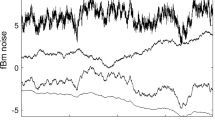Abstract
Experimental time-series of human H-reflexes were analyzed for the presence of fractal structure or deterministic chaos. Surrogate data sets consisting of stochastic time-series with preservation of selected properties of the experimental time-series were used as mathematical controls. Artifacts generated during the analysis of the experimental data are identified, and shown to be due to linear correlation in the original time-series. The method is simple and generally applicable to the non-linear analysis of time-series from any experimental system.
Similar content being viewed by others
References
Albano AM, Muench J, Schwartz C, Mees AI, Rapp PE (1988) Singular-value decomposition and the Grassberger-Procaccia algorithm. Phys Rev A 38:3017–3026
Babloyantz A, Destexhe A (1986) Low-dimensional chaos in an instance of epilepsy. Proc Natl Acad Sci 83:3513–3517
Basar E (1990) Chaos and brain function. Springer, Berlin Heidelberg New York, 176 pp
Braddom RL, Johnson EW (1974) H reflex: review and classification with suggested clinical uses. Arch Phys Med Rehabil 55:412–417
Braddom RL, Schuchmann J (1980) Motor conduction. In: Johnson WE (ed) Practical electromyography. Williams and Wilkins, Baltimore, pp 16–60
Grassberger P (1986) Do climatic attractors exist? Nature 323:609–612
Grassberger P, Procaccia I (1983a) Measuring the strangeness of strange attractors. Physica D 9:189–208
Grassberger P, Procaccia I (1983b) Estimation of the Kolmogorov entropy from a chaotic signal. Phys Rev A 28:2591–2593
Henneman E (1980) Organization of the motoneuron pool. In: Mountcastle VB (ed) Medical physiology. Mosby, St. Louis, pp 718–741
King CC (1991) Fractal and chaotic dynamics in nervous systems. Prog Neurobiol 36:279–308
Kostelich EJ, Yorke JA (1990) Noise reduction: finding the simplest dynamical system consistent with the data. Physica D 41:183–196
Mandelbrot BB (1983) The fractal geometry of nature. Freeman, New York, 468 pp
Molt JT, Gasteiger EL (1976) Variability in spinal reflexes: A correlation with spontaneous slow wave activity in cat spinal cord. Exp Neurol 52:132–145
Osborne AR, Provenzale A (1989) Finite correlation dimension for stochastic systems with power-law spectra. Physica D 35:357–381
Packard NH, Crutchfield JP, Farmer JD, Shaw RS (1980) Geometry from a time series. Phys Rev Lett 45:712–716
Panizza M, Nilsson J, Hallett M (1989) Optimal stimulus duration for the H-reflex. Muscle and Nerve 12:576–579
Provenzale A, Osborne AR, Soj R (1991) Convergence of the K2 entropy for random noises with power-low spectra. Physica D 47:361–372
Rall W, Hunt CC (1956) Analysis of reflex variability in terms of partially correlated excitability fluctuations in a population of motoneurons. J Gen Physiol 39:397–442
Rudomin P, Dutton H (1969) Effects of conditioning afferent volleys on variability of monosynaptic responses of extensor motoneurons. J Neurophysiol 32:140–157
Schiff SJ (1991) Human spinal cord reflex variability: noise versus chaos. Soc Neurosci Abstr 17:642
Sherrington CS (1909) The integrative action of the nervous system. University Press, Cambridge, 433 pp
Smith LA (1988) Intrinsic limits on dimension calculations. Phys Lett A 133:283–288
Somjen GG, Heath CJ (1966) Covariation of monosynaptic reflexes in spinal and decerebrate cats. Exp Neurol 15:79–99
Sugihara G, May RM (1990) Nonlinear forecasting as a way of distinguishing chaos from measurement error in time series. Nature 344:734–741
Theiler J (1988) Quantifying chaos: practical estimation of the correlation dimension (thesis), University Microfilms International, Ann Arbor, 256 pp
Theiler J, Galdrikian B, Longtin A, Eubank S, Farmer JD (1991) Using surrogate data to detect nonlinearity in time series. In: Casdagli M, Eubank S (eds), Nonlinear prediction and modeling, Addison Wesley, Redwood City
Voss RF (1989) Random fractals: self-affinity in noise, music, mountains, and clouds. Physica D 38:362–371
Wolf A, Swift JB, Swinney HL, Vastano JA (1985) Determining lyapunov exponents from a time series. Physica D 16:285–317
Author information
Authors and Affiliations
Rights and permissions
About this article
Cite this article
Schiff, S.J., Chang, T. Differentiation of linearly correlated noise from chaos in a biologic system using surrogate data. Biol. Cybern. 67, 387–393 (1992). https://doi.org/10.1007/BF00200982
Received:
Accepted:
Issue Date:
DOI: https://doi.org/10.1007/BF00200982




